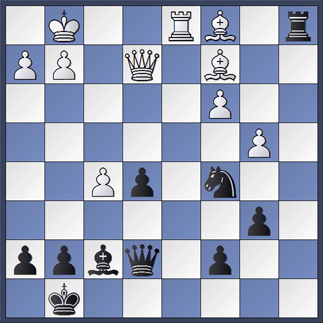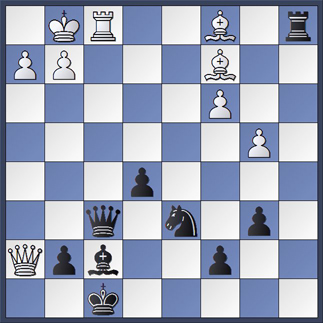After the first day of the Far West Open, my perfect score for the year is still intact — two wins, no draws, no losses. But it took an amazing stroke of luck for me to win the second game!
There are 11 titled players here, quite a respectable showing, given the competition from Foxwoods. Some of the usuals came: boards one and two were Sergei Kudrin and Melikset Khachiyan. Jesse played on board five both rounds, and David was on board eight.
In the first round things went pretty much by the book, with no upsets on any of the top boards in the Open section. I was paired down against a player rated 1850, and won a fairly smooth game as Black. My opponent seemed to be a very cautious player — every time he had a chance to play for some complications, he decided not to. But ironically, the only time that he played an aggressive move, it turned out to be his downfall!
In the second round I had Black against IM Vladimir Mezentsev. The game was a quiet Two Knights Defense (1. e4 e5 2. Nf3 Nc6 3. Bc4 Nf6 4. d3), and I thought that I handled the position really well up until I got into time trouble. Then, as so often happens, crazy things started happening. I had about 8 minutes left to make 10 moves from this position:
Black to move.
Here the time pressure got to me and I blundered with 31. … Nb7? According to Fritz I should have played 31. … Nd7, and White has only a slight advantage (0.4 pawns). If you want to make this position into a quiz, see if you can figure out what is wrong with 31. … Nb7.
If you answered 32. Qe4, then you made the same error in thinking that I did. Go back and listen again to my ChessLecture on “Reversing the Move Order.” 32. Qe4? is met effectively by 32. … Nd6, when White does not have time for 33. f6? Nxe4 34. fe Nd6. Instead, White should (and did) play 32. f6! With this reversal of the “expected” move order, he secures close to a winning advantage. I had to play 32. … Qxf6, and now 33. Qe4! Nd6 34. Qxh7+ Kf8 35. Rf1 and it looks as if Black is done for.
At first I was pretty discouraged here, but then I started to notice some amazing swindling possibilities. With less than two minutes left on my clock, I played 35. … Qxf1+! Incidentally, according to Fritz, this isn’t just a swindle, it’s actually Black’s best move. The game continued 36. Kxf1 Rxc1+ and now White blundered with 37. Ke2? He had to play 37. Kf2, but even on this it’s worth noting that Black gets huge counterplay: 37. … Bg8! 38. Qd3 e4! 39. Qe2 (if 39. Qd2? e3+! wins material) 39. … Bc4 40. Qd2 Rf1+ 41. Ke3 etc. Although Fritz gives White about a 0.9-pawn advantage, Black’s pieces are wonderfully active and it will be very challenging for White to actually win this game.
But Vladimir had no sense of danger here. In fact, my time pressure actually worked to my advantage, because I think it looked to him as if my move 35. … Qxf1+ was just a desperate time-pressure move that didn’t have any real threats. He played his moves very rapidly here, like a person who has nothing to worry about.
Position after 37. Ke2? (Black to play)
I played 37. … Bg8! Vladimir still suspected nothing, and played 38. Qd3?? He could still have gotten a draw by repetition with 38. Qg6 Bf7 39. Qh7 Bg8 etc. Any other move would lose the bishop on c2. But his move 38. Qd3 loses a whole lot more — it loses the queen after 38. … Bc4! So my half-point swindle became a full-point swindle, and White resigned.
Even though this was very lucky, I do feel as if I made some good positional judgements earlier in the game that made my “stroke of good fortune” possible. Opening the a-file and penetrating with the rook to a1 turned out to be very important. Also, I had for a long time tried to get White to commit to b3-b4 so that I could control the c4 square — and that indeed turned out to be the key square in the combination.
Now it’s time to get some sleep so that I can (I hope) pull off some more upsets in Saturday’s games!
P.S. Jesse and David also went 2-0.






{ 3 comments… read them below or add one }
Good job. Could this be just another case of players underestimating the value of pieces? Our strongest bias when it comes to estimating piece value is that the queen has more worth than two pieces. This is generally true in most instances but there are few exceptions and the “quality” of the remaining pieces for both sides matters significantly also. I write about this in my book.
As you pointed out, White was still ahead and could have drawn but he was clearly operating under false assumptions and thus explains his failure to look for drawing possibilities and moving quickly feeling secured.
The combination starting with f6 looks strong but the net gain for White was small. I wonder if there are other ways to continue by playing against the temporarily marginalized knight on b7. Could he have prepared f6 with Rf1?
I had a similar win against FM Boor at the 19th North American FIDE Invitational but there the bishop was on h7 and the queen was on c2. But the difficulty for the first player was similar in that White’s queen had to keep the contact with the bishop unbroken. The winning idea was similar in that I had to chase the queen to break the contact.
By the way I won my first ever win against an IM in the same tournament.
Good luck in your next round. How is GM Gurevich doing?
Andy
Nice game and good luck!
Hi Andy,
Gurevich is having kind of a so-so tournament. Going into the last round he has 3.5 points, with two wins followed by three straight draws. Still, he definitely has a chance to make some good money in the last round.
{ 1 trackback }